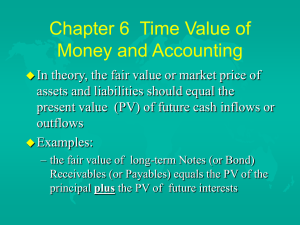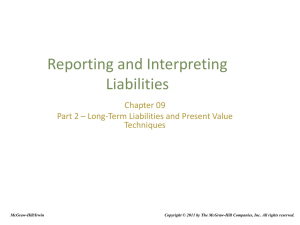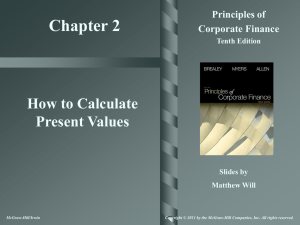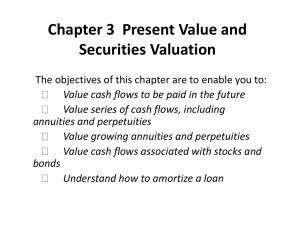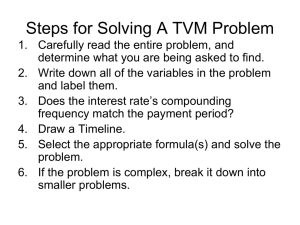Present value of an annuity
advertisement
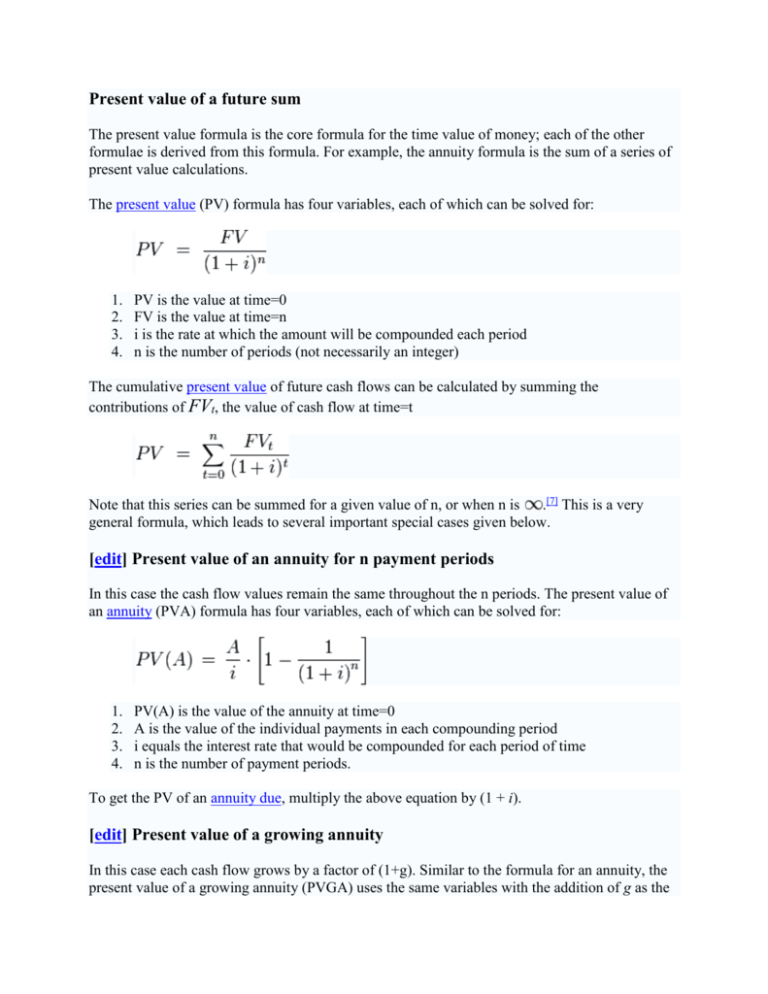
Present value of a future sum The present value formula is the core formula for the time value of money; each of the other formulae is derived from this formula. For example, the annuity formula is the sum of a series of present value calculations. The present value (PV) formula has four variables, each of which can be solved for: 1. 2. 3. 4. PV is the value at time=0 FV is the value at time=n i is the rate at which the amount will be compounded each period n is the number of periods (not necessarily an integer) The cumulative present value of future cash flows can be calculated by summing the contributions of FVt, the value of cash flow at time=t Note that this series can be summed for a given value of n, or when n is .[7] This is a very general formula, which leads to several important special cases given below. [edit] Present value of an annuity for n payment periods In this case the cash flow values remain the same throughout the n periods. The present value of an annuity (PVA) formula has four variables, each of which can be solved for: 1. 2. 3. 4. PV(A) is the value of the annuity at time=0 A is the value of the individual payments in each compounding period i equals the interest rate that would be compounded for each period of time n is the number of payment periods. To get the PV of an annuity due, multiply the above equation by (1 + i). [edit] Present value of a growing annuity In this case each cash flow grows by a factor of (1+g). Similar to the formula for an annuity, the present value of a growing annuity (PVGA) uses the same variables with the addition of g as the rate of growth of the annuity (A is the annuity payment in the first period). This is a calculation that is rarely provided for on financial calculators. Where i ≠ g : To get the PV of a growing annuity due, multiply the above equation by (1 + i). Where i = g : [edit] Present value of a perpetuity When , the PV of a perpetuity (a perpetual annuity) formula becomes simple division. When this is an increasing perpetuity, this i becomes i’ 1+i’=(1+i)/(1+g) i’=(i-g)/(1+g) so A/i’ = A x (1+g)/(i-g) not (A/(i-g)) [edit] Present value of a growing perpetuity When the perpetual annuity payment grows at a fixed rate (g) the value is theoretically determined according to the following formula. In practice, there are few securities with precisely these characteristics, and the application of this valuation approach is subject to various qualifications and modifications. Most importantly, it is rare to find a growing perpetual annuity with fixed rates of growth and true perpetual cash flow generation. Despite these qualifications, the general approach may be used in valuations of real estate, equities, and other assets. This is the well known Gordon Growth model used for stock valuation. [edit] Future value of a present sum The future value (FV) formula is similar and uses the same variables. [edit] Future value of an annuity The future value of an annuity (FVA) formula has four variables, each of which can be solved for: 1. 2. 3. 4. FV(A) is the value of the annuity at time = n A is the value of the individual payments in each compounding period i is the interest rate that would be compounded for each period of time n is the number of payment periods [edit] Future value of a growing annuity The future value of a growing annuity (FVA) formula has five variables, each of which can be solved for: Where i ≠ g : Where i = g : 1. 2. 3. 4. 5. FV(A) is the value of the annuity at time = n A is the value of initial payment at time 0 i is the interest rate that would be compounded for each period of time g is the growing rate that would be compounded for each period of time n is the number of payment periods [edit] Derivations [edit] Annuity derivation The formula for the present value of a regular stream of future payments (an annuity) is derived from a sum of the formula for future value of a single future payment, as below, where C is the payment amount and n the period. A single payment C at future time m has the following future value at future time n: Summing over all payments from time 1 to time n, then reversing the order of terms and substituting k = n − m: Note that this is a geometric series, with the initial value being a = C, the multiplicative factor being 1 + i, with n terms. Applying the formula for geometric series, we get The present value of the annuity (PVA) is obtained by simply dividing by (1 + i)n: Another simple and intuitive way to derive the future value of an annuity is to consider an endowment, whose interest is paid as the annuity, and whose principal remains constant. The principal of this hypothetical endowment can be computed as that whose interest equals the annuity payment amount: Principal = C / i + goal Note that no money enters or leaves the combined system of endowment principal + accumulated annuity payments, and thus the future value of this system can be computed simply via the future value formula: FV = PV(1 + i)n Initially, before any payments, the present value of the system is just the endowment principal (PV = C / i). At the end, the future value is the endowment principal (which is the same) plus the future value of the total annuity payments (FV = C / i + FVA). Plugging this back into the equation: [edit] Perpetuity derivation Without showing the formal derivation here, the perpetuity formula is derived from the annuity formula. Specifically, the term: can be seen to approach the value of 1 as n grows larger. At infinity, it is equal to 1, leaving the only term remaining. as [edit] Examples [edit] Example 1: Present value One hundred euros to be paid 1 year from now, where the expected rate of return is 5% per year, is worth in today's money: So the present value of €100 one year from now at 5% is €95.23. [edit] Example 2: Present value of an annuity — solving for the payment amount Consider a 10 year mortgage where the principal amount P is $200,000 and the annual interest rate is 6%. The number of monthly payments is and the monthly interest rate is The annuity formula for (A/P) calculates the monthly payment: [edit] Example 3: Solving for the period needed to double money Consider a deposit of $100 placed at 10% (annual). How many years are needed for the value of the deposit to double to $200? Using the algrebraic identity that if: then The present value formula can be rearranged such that: (years) This same method can be used to determine the length of time needed to increase a deposit to any particular sum, as long as the interest rate is known. For the period of time needed to double an investment, the Rule of 72 is a useful shortcut that gives a reasonable approximation of the period needed. [edit] Example 4: What return is needed to double money? Similarly, the present value formula can be rearranged to determine what rate of return is needed to accumulate a given amount from an investment. For example, $100 is invested today and $200 return is expected in five years; what rate of return (interest rate) does this represent? The present value formula restated in terms of the interest rate is: see also Rule of 72 [edit] Example 5: Calculate the value of a regular savings deposit in the future. To calculate the future value of a stream of savings deposit in the future requires two steps, or, alternatively, combining the two steps into one large formula. First, calculate the present value of a stream of deposits of $1,000 every year for 20 years earning 7% interest: This does not sound like very much, but remember - this is future money discounted back to its value today; it is understandably lower. To calculate the future value (at the end of the twentyyear period): These steps can be combined into a single formula: [edit] Example 6: Price/earnings (P/E) ratio It is often mentioned that perpetuities, or securities with an indefinitely long maturity, are rare or unrealistic, and particularly those with a growing payment. In fact, many types of assets have characteristics that are similar to perpetuities. Examples might include income-oriented real estate, preferred shares, and even most forms of publicly-traded stocks. Frequently, the terminology may be slightly different, but are based on the fundamentals of time value of money calculations. The application of this methodology is subject to various qualifications or modifications, such as the Gordon growth model. For example, stocks are commonly noted as trading at a certain P/E ratio. The P/E ratio is easily recognized as a variation on the perpetuity or growing perpetuity formulae - save that the P/E ratio is usually cited as the inverse of the "rate" in the perpetuity formula. If we substitute for the time being: the price of the stock for the present value; the earnings per share of the stock for the cash annuity; and, the discount rate of the stock for the interest rate, we can see that: And in fact, the P/E ratio is analogous to the inverse of the interest rate (or discount rate). Of course, stocks may have increasing earnings. The formulation above does not allow for growth in earnings, but to incorporate growth, the formula can be restated as follows: If we wish to determine the implied rate of growth (if we are given the discount rate), we may solve for g: [edit] Time value of money formulas with continuous compounding Rates are sometimes converted into the continuous compound interest rate equivalent because the continuous equivalent is more convenient (for example, more easily differentiated). Each of the formulæ above may be restated in their continuous equivalents. For example, the present value at time 0 of a future payment at time t can be restated in the following way, where e is the base of the natural logarithm and r is the continuously compounded rate: See below for formulaic equivalents of the time value of money formulæ with continuous compounding. [edit] Present value of an annuity [edit] Present value of a perpetuity [edit] Present value of a growing annuity [edit] Present value of a growing perpetuity [edit] Present value of an annuity with continuous payments


